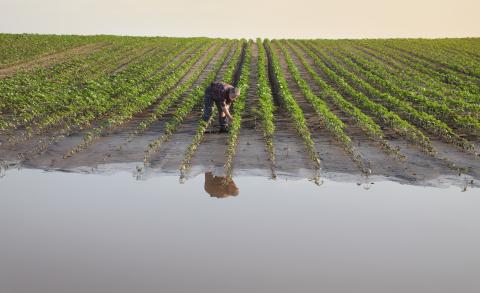
Warming temperatures and increased rains caused by climate change continue to have real impacts on farms across Minnesota. Our agriculture industry will also play an important role in reducing the amount climate change causing pollution we produce as a state.
Changes challenge crop production
Changes to Minnesota's climate will alter the way we have grow food in our state. Some of the changes we can anticipate:
- Crop yields may be impacted by changes in temperature, humidity, cloud cover, and precipitation trends as well as extremes. There may be a positive, negative or no effect on crop yields.
- Crop losses may increase due to both direct and indirect impact from weeds, insects, and diseases that accompany changes in both average weather trends and extreme weather events.
- Annual variations in crop production are expected to increase due to climate change effects on weather patterns and increases in extreme weather events.
- Soil and water quality and quantity are expected to decline due to increasing extremes in precipitation.
Animals feel the heat
Animal health, growth, and reproduction are also highly sensitive to temperature changes. Higher summer temperatures may lead to increased deaths due to heat stress, lower production of milk from dairy cattle and eggs from poultry, slower weight gain and corresponding longer time to market, and decreased reproduction that can result in smaller herds. Heat-stressed hogs eat less, and heat may interfere with breeding, gestation, and lactation. According to USDA, high summer heat costs the American swine industry more than $300 million annually.
Farming with climate change in mind
Agriculture also accounts for approximately one-quarter of Minnesota’s greenhouse gas emissions, so strategies to reduce emissions from this sector are critical to reaching statewide goals. In addition to greenhouse gas reduction benefits, some strategies may help farmers maintain soil health and reduce erosion, which will help them adapt to warmer and wetter climate conditions.
Many Minnesota farmers already implement good land management practices like planting shelterbelt trees and reducing tilling to protect soil health and water quality. Through best practices, Minnesota farms can reduce greenhouse emissions and even remove greenhouse gases from the atmosphere to be part of our climate solution. Implementing these practices across Minnesota's 20 million acres of cropland could reduce overall agriculture emissions by 5-10%.
Minnesota should support farmers with funding and technical assistance to implement these practices. Widespread implementation of these practices will be good for farmers, good for Minnesota’s water quality, and good for the global environment. Early adopters of these practices are already making a difference. Water and soil conservation programs from the Board of Water and Soil Resources have reduced cropland agriculture emissions by 600,000 tons per year, approximately 1% of cropland emissions.
Agricultural best practices report
This technical report reviews 27 best practices to reduce greenhouse gas emissions from agriculture and make farms more resilient to the impacts of climate change.